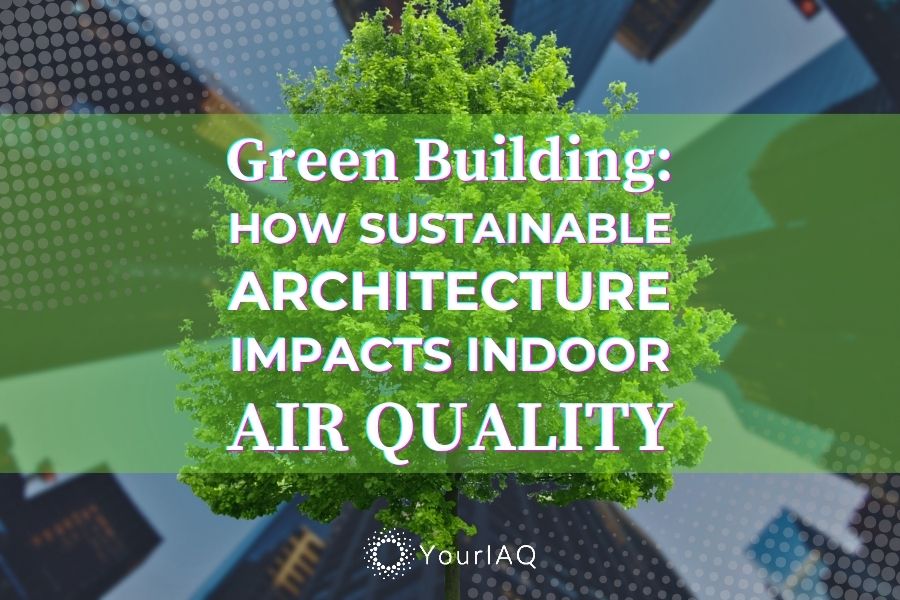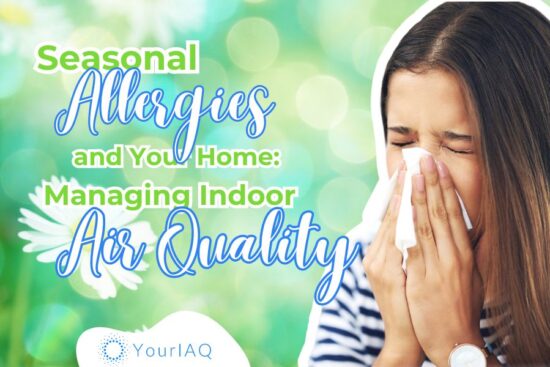
While we often focus on outdoor air pollution, the air inside our homes and workplaces can be equally harmful to our health – causing sick building syndrome. Green buildings, however, prioritize ventilation and low-VOC materials, ensuring cleaner air.
The average American home contains over 600 potentially harmful air pollutants, including chemicals and mold spores. According to the Environmental Protection Agency (EPA), indoor air quality (IAQ) ranks among the top five environmental risks to public health.
Since we spend 90% of our time indoors, exposure to indoor air pollutants like mold, chemicals, and particulate matter in the built environment is a pervasive yet overlooked issue. Thankfully, the green building movement provides a solution to improve indoor air quality and create a healthier indoor air environment.
Green buildings and air quality go hand-in-hand.
How?
Sustainable green building design integrates eco-friendly practices into:
- Planning
- Construction
- Operation
A core focus? Prioritizing indoor environmental quality and air quality to safeguard human health. In this article, we explore how green building techniques improve indoor air quality. It covers energy efficiency, sustainable materials, and optimized ventilation to reduce indoor air pollution.
Learn how these eco-conscious principles of sustainable design for air quality can create living and working spaces that promote respiratory health, cognitive function, and overall vitality – while minimizing environmental impact.
How Green Buildings Improve Air Quality
Traditional buildings often overlook the impact of design and building operations on good indoor air quality. Let’s explore how green buildings ensure cleaner indoor air:
Energy Efficiency Reduces Indoor Air Pollution
Energy-efficient buildings have dramatically cleaner indoor air because they rely less on HVAC systems that circulate pollutants. Highly insulated walls and windows retain heated/cooled air better, reducing the need for:
- Dust-filled air circulation
- Combustion-powered climate control that releases chemicals and carbon dioxide
- Excessive air conditioning that can raise humidity levels
Low-energy lighting also lowers heat and ozone production. Overall, the energy-efficient design creates a healthier indoor environment by reducing our reliance on systems that degrade indoor air quality.
Sustainable Materials Limit Off-Gassing for Cleaner Indoor Air
Beyond energy use, the very materials a building is made of significantly impact indoor air quality.
Conventional building materials such as insulations, adhesives, paints, and furnishings emit volatile organic compounds (VOCs), like formaldehyde, that pollute indoor air quality. Green buildings use eco-friendly alternatives that limit harmful off-gassing, such as:
- Low/no-VOC finishes
- Natural woods and fibers
- Recycled products
Using local supplies also reduces emissions that can end up indoors.
Water Conservation Prevents Moisture Issues Harming Indoor Air Quality
Green buildings manage water wisely to protect indoor air quality by reducing moisture that enables mold growth. Low-flow fixtures reduce moisture/humidity which enables mold growth. Other strategies include:
- Xeriscaping
- Permeable landscaping
- Proper roof and drainage systems
Xeriscaping and permeable landscaping prevent dampness from entering buildings. Properly pitched roofs and drainage systems channel water away to control humidity levels inside for improved air quality in the built environment.
Green Design Strategies Focused on Indoor Air Quality
Here, we explore key strategies employed in green buildings to enhance indoor air quality, including ventilation enhancements, the selection of non-polluting materials, and moisture management techniques.
Ventilation is Critical for Healthy Indoor Air
Ventilation is key for indoor environmental quality in green buildings. It introduces outdoor air to dilute and remove indoor pollutants. Strategies include:
- Energy recovery ventilation systems cycle fresh and stale air
- Advanced filters capture particulates, VOCs, and bio-contaminants
- Operable windows and atriums allow in outdoor air
Green Buildings Choose Pollutant-Free Materials
Green building selects construction materials that limit indoor air pollution sources. Examples of green materials are:
- Formaldehyde-free insulation/wood
- Zero/low-VOC paints and sealants
- PVC-free flooring
- Natural fabrics and furniture
Using building “exhaust” systems during construction clears contaminants for improved indoor air.
Moisture Management Prevents Mold
Moisture is the root cause enabling hazardous mold growth that compromises indoor air quality. So green buildings:
- Install drainage and vapor barriers
- Use dehumidifiers
- Specify mold-resistant materials
- Employ air sealing to stop condensation
Health Benefits of Green Building’s Improved Indoor Air
Building green isn’t just about the planet—it’s about people. Improved indoor air quality (IAQ), a hallmark of green building practices, directly contributes to fewer respiratory problems, better cognitive function, and enhanced overall well-being.
Reduced Respiratory Issues
Poor indoor air filled with particulates, mold spores, VOCs, and other pollutants is a major trigger for conditions like asthma, allergies, and chronic bronchitis. Green buildings remove these pollutants for cleaner air. This eases inflammation and symptoms, especially benefiting:
- Children
- Elderly
- Immunocompromised
But the benefits of green building air quality extend far beyond breathing easier…
Cognitive Benefits of Green Buildings’ Enhanced Air Quality
Numerous studies link poor indoor air quality to fatigue, headaches, and concentration difficulties – likely caused by inhaling CO2 buildup and other airborne contaminants.
Improved ventilation and removal of pollutants in green buildings help support optimal brain function, productivity, and academic performance.
Overall Well-Being from Breathing Cleaner Indoor Air
Beyond physical respiratory health, breathing cleaner indoor air in green buildings reduces oxidative stress and allows the mind and body to operate at peak levels. The advantages of cleaner IAQ include:
- Decreased allergy and asthma symptoms, providing relief to sufferers and reducing the need for medication.
- Enhanced sleep quality, as cleaner air contributes to a more restful and restorative sleep.
- Boosted energy levels, with fewer pollutants to drag down the body’s systems.
- Improved emotional state, as better air quality can reduce stress levels and enhance mood.
- Stronger immune system, as the body is less burdened by fighting off the effects of indoor pollutants.
The result? Greater health and vitality.
Green Building’s Environmental Benefits Extend to Indoor Air
Green buildings fight climate change and air pollution on multiple fronts. From reducing energy consumption to preserving natural resources, these designs actively promote cleaner air – both indoors and out.
Lower Carbon Footprint
By maximizing insulation, natural lighting, and passive heating/cooling, green buildings dramatically improve energy efficiency and reduce reliance on fossil fuel consumption for heating and electricity. This curbs CO2 emissions, a major contributor to climate change and outdoor air pollution.
Resource Conservation Protects Overall Air Quality
Sustainable designs prioritize:
- Using recycled/recyclable materials
- Reducing construction waste
- Minimizing water usage
This extends raw material lifespans and preserves precious resources like timber and water reserves with less pollution.
Healthy Ecosystems
Green buildings help keep whole ecosystems thriving, directly impacting the air we breathe. Here’s how:
- Sustainable practices protect forests, and nature’s air filters, reducing pollution that ends up in our buildings.
- By minimizing harm to land and water, green buildings promote healthy ecosystems that regulate air quality on a vast scale.
The Future of Healthy Indoor Air Through Green Building
Climate change is speeding up and affecting human health. Green buildings can help improve indoor air quality and reduce environmental pressures.
By fusing sustainable design with strategies to purify indoor air, these high-performance green buildings allow us to breathe more easily. At the same time, responsibly built green buildings harmonize with nature to protect air quality on a larger scale.
Ready to transform your space into a healthier environment? Explore the power of green building today!
See also: Home Building Standards and Indoor Air Quality
Ten Key Takeaways on Green Buildings and Indoor Air Quality
| Key takeaways |
| Conventional buildings can expose us to sick building syndrome and polluted indoor air. |
| Green building principles prioritize indoor environmental quality and occupant health. |
| Energy efficiency, sustainable construction materials and proper ventilation improve indoor air. |
| Controlling moisture prevents hazardous mold growth indoors. |
| Low-VOC materials limit off-gassing of harmful chemicals. |
| Optimized HVAC systems and filters clean indoor air continuously. |
| Better indoor air quality reduces respiratory issues like asthma and allergies. |
| Enhanced air quality supports cognitive function, productivity and overall well-being. |
| Green buildings lower carbon footprints and outdoor air pollution sources. |
| Sustainable construction benefits surrounding environments and communities. |
FAQs on Green Building and Indoor Air Quality
Is green building more expensive for improved indoor air quality?
Initially, yes. Green building practices involving better ventilation and low-emission materials can have higher upfront costs. However, these designs often lead to long-term savings in health expenses and energy costs.
Where can I find green building indoor air quality resources?
EPA (Environmental Protection Agency): https://www.epa.gov/indoor-air-quality-iaq
USGBC (US Green Building Council): https://www.usgbc.org/leed
World Green Building Council: https://www.worldgbc.org/
Can I retrofit my home for better indoor air quality?
Yes! Retrofits can include sealing air leaks, improving ventilation, using low-VOC materials, and adding air purifiers.
How do I verify a building’s indoor air quality performance?
Hire a professional to measure pollutants and air exchange rates. Look for buildings with green certifications like LEED or WELL for better indoor air quality standards.
How do green buildings impact indoor air quality?
Green buildings prioritize fresh air intake and filtration. They minimize the use of materials releasing VOCs and other pollutants. Natural daylighting reduces reliance on artificial lighting and improves overall well-being.
What is indoor environmental quality in green buildings?
Indoor environmental quality (IEQ) goes beyond air quality, addressing:
- Thermal comfort (temperature, humidity)
- Lighting (quality and access to natural light)
- Acoustics (noise control)
What are the effects of indoor air quality in buildings?
Poor IAQ can cause respiratory issues, allergies, headaches, fatigue, and long-term illnesses. Good IAQ promotes better health. Improved IAQ enhances the cognitive function, focus, and overall well-being of occupants.
Do certification programs guarantee improved air quality?
Certification programs offer a strong indication that a building prioritizes healthy indoor air. Yet, it’s wise to investigate the specific building and the certification it holds to gain a full understanding of its air quality potential.






